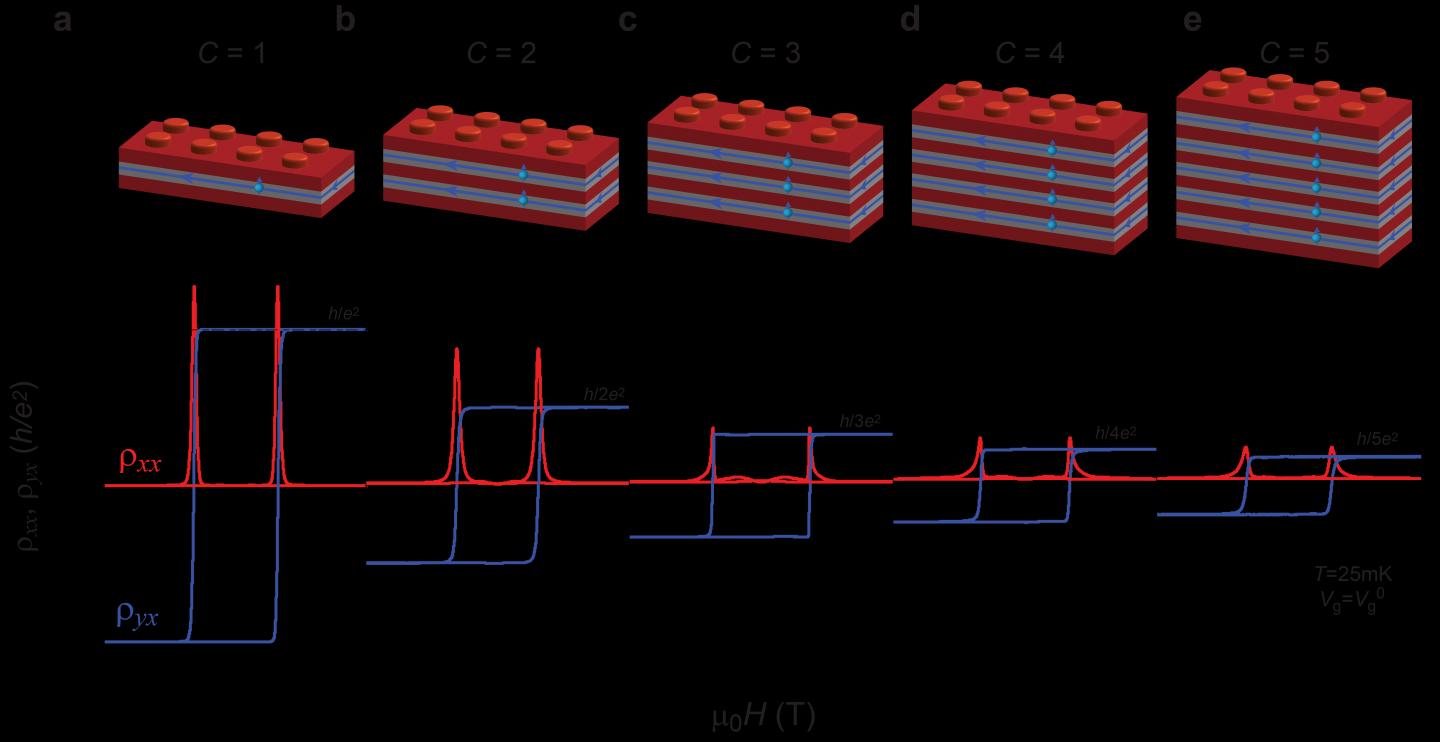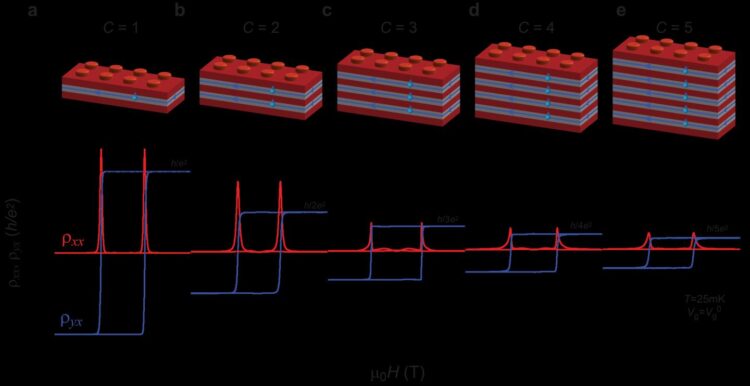
Credit: Zhao et al., Nature
New energy-efficient electronic devices may be possible thanks to research that demonstrates the quantum anomalous Hall (QAH) effect — where an electrical current does not lose energy as it flows along the edges of the material — over a broader range of conditions. A team of researchers from Penn State has experimentally realized the QAH effect in a multilayered insulator, essentially producing a multilane highway for the transport of electrons that could increase the speed and efficiency of information transfer without energy loss.
“Low energy consumption is key in electronic devices, so there is a lot of research into materials that can improve the efficiency of electron flow,” said Cui-Zu Chang, assistant professor of physics at Penn State who led the research. “Increasing the number of electrons in most metals results in a sort of traffic jam because electrons moving in different directions get scattered and repel each other. But in QAH insulators, electron flow is constrained to the edges, and electrons on one edge can only go in one direction and those on the other edge can only go the opposite direction, like splitting a road into a two-lane highway. In this study, we fabricated QAH insulators that could be layered to essentially create parallel highways on top of each other.”
QAH insulators are created in a material called a topological insulator — a thin layer of film with a thickness of only a couple dozen atoms — that have been made magnetic so that they only conduct current along the edges. To make topological insulators magnetic, researchers add magnetic impurities into the material in a process called diluted magnetic doping. In this study, the Penn State research team used a technique called molecular beam epitaxy to fabricate multilayered topological insulators, carefully controlling where magnetic doping occurred.
“QAH insulators are of particular interest because they theoretically have no energy dissipation, meaning that electrons do not lose energy in the form of heat as electrical current flows along the edges,” said Chao-Xing Liu, associate professor of physics at Penn State and coauthor of the paper. “This unique property makes QAH insulators a good candidate for use in quantum computers and other small, fast electronic devices.”
In prior studies, the QAH effect had been experimentally realized only in materials where an important quantity called the Chern number had a value of 1, essentially with a single two-lane highway for electrons. In this study, the researchers stacked alternating layers of magnetic and non-magnetic topological insulators and were able to realize the QAH state with Chern numbers up to 5, essentially constructing 5 parallel highways for electrons on each side of the material for a total of 10 lanes. They present their results in a paper appearing online Dec. 16 in the journal Nature.
“We do see some dissipation of current at connection points between QAH insulators and metallic electrodes, which occurs in the form of heat,” said Liu. “You can think of it like the on and off ramps of a busy highway, where the narrow merge lane into local traffic slows you down. By building more parallel highways, more merge lanes can connect the highways to local traffic, so that the overall speed of the whole traffic system can be greatly improved.”
The researchers found that by increasing the thickness of the QAH insulator layers, or by manipulating the concentration of magnetic doping in the QAH layer, they could tune the Chern number of the sample. “In other words, we could change the number of lanes in the highway with an external knob,” said Chang. “Even at high Chern numbers, the QAH insulators had no dissipation along the edge channels. This provides a proof-of-concept for devices that take advantage of this dissipationless edge current.”
In this study, the researchers carefully fabricated separate QAH insulators with different Chern numbers. In the future, they hope to develop a technique to tune the Chern number of an already fabricated sample, for “real-time” control of the electron traffic in an information highway.
Translating the fundamental advance made in this study into a practical technology is still a challenge since the phenomena studied here are limited to very low temperatures–about a hundredth of a degree Kelvin above absolute zero. But Chang is optimistic: “Through creative material synthesis, we can envision scenarios that might help us realize these effects under technologically relevant conditions.”
###
In addition to Chang and Liu, the research team at Penn State includes graduate students Yi-Fan Zhao, Ruoxi Zhang, Ruobing Mei, Ling-Jie Zhou, Ya-Qi Zhang, Jiabin Yu, and Run Xiao; postdoctoral researcher Hemian Yi; Materials Research Institute staff scientist Ke Wang; and faculty members Nitin Samarth and Moses H. W. Chan.
This work was primarily supported by the Department of Energy. Additional support was provided by the U.S. Army Research Office, the National Science Foundation, and the Gordon and Betty Moore Foundation.
Media Contact
Gail McCormick
[email protected]
Original Source
https:/
Related Journal Article
http://dx.





